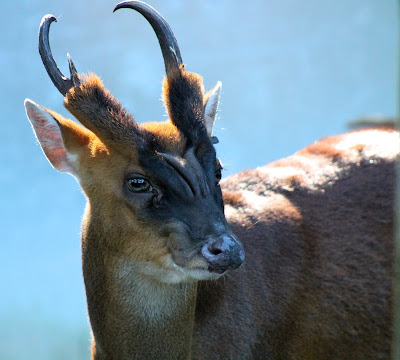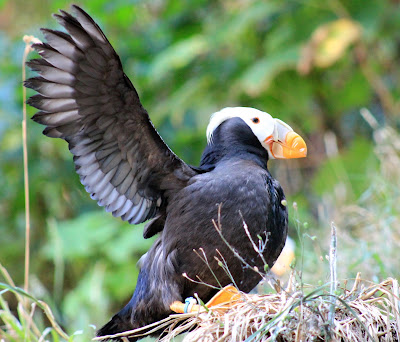Website:
www.sequoiaparkzoo.net
The primary links on the zoo's website are Visit, Animals, Conservation, Education, About, Membership, and Donate. Fairly standard primary links. The Visit link takes you to where you can see a map of the zoo, get hours, admission prices, etc. It also has a page for "zoo manners" on how to behave at the zoo. They did not have the summer hours posted when I looked, which would have been nice to know for this review. Disappointingly, the Animals link is merely a link to a page about the general exhibit spaces with only a single paragraph of general information about each. No animals fact sheets. The page on Conservation includes the various conservation partnerships the zoo participates in, as well as pages on how the public can help conserve wildlife both locally and around the world. Most interesting are the set of conservation lecture videos and a link to a local citizen science project.
Admissions Prices:
Adults (13-59) $10
Military (ID) $7
Seniors (60+) $7
Children (3-12) $6
Babies (0-2) Free
Hours:
Winter hours (October 1st - April 30th)
Monday 12pm - 4pm
Tuesday-Sunday 10am - 5pm
Zoo:
Sequoia Park zoo is located across from an elementary school in Eureka, CA. It is very accessible by bus, with a bus stop less than a block away. The entire zoo is very accessible by wheelchair, even the exhibits with tall viewing walls have low windows in those walls which children or people in wheelchairs can more easily see through. You are not given a map of the zoo as you enter, but it is hardly necessary as the park is quite small. There is a large map over by the memorial to the zoo's last chimp, but it is an out-of date map.
The only place to get food is a small cafe/fast food stand right next to the entrance and the gift shop. Not a huge variety of options, but good enough and not overly expensive. Outdoor seating is both in the sun or shade, but indoor seating for rainy/cold winter days is limited to about 3 tables. Inadequate for even a small zoo's visitor numbers on a rainy/cold day. There are two bathroom facilities in the park, one near the entrance and the other at the far end of the park in the farmyard area.
The areas for children to play in are numerous for such a small zoo. Right past the entrance is a fantastic water feature for children to splash around in, the indoor area has a wide variety of interactive learning activities, and the barn has both sculptures to climb on and animals to pet. An excellent zoo to bring young children to.
 |
| A stream to splash in |
 |
| Indoor discovery space |
The different exhibit areas at the zoo are the primates, bush dogs, river otters, birds of prey aviary, flamingos, free-flight aviary, cavy yard, red pandas, barnyard, and local reptiles and amphibians.
The identification signs for each exhibit were great. Almost every single one had both the common and scientific names along with the species' endangered status, whether or not it was part of an SSP (species survival plan), where the species originates, and other basic information. Every species was identified by a sign.
 |
 |
| A sign by the salmon exhibit |
 |
| Right next to the viewing window of the otters |
 |
| An interactive mural for teaching about habitat protection |
 |
| One of many signs about creating wildlife habitat |
 |
| Feeding and talking about the salmon |
As a small zoo, I can understand that they do not have as much money for rebuilding outdated exhibits. However, the primate facilities were disappointing. The cages were small for the arboreal species, and as they were made of fine metal fencing it was hard to get a very clear view of the animals. The zoo has plans to create some new exhibits in currently unused areas, but they could do with expanding and modernizing the primate enclosures first.
The only animal interaction area was the barnyard petting area. It was designed so that a selection of goats, sheep, rabbits and chickens could choose to be in the petting yard or move on their own into several no-human zones if they did not wish to be approached. There was no supervision by a staff member of this area, and though I did not see anyone behaving badly, some supervision of interaction between the public and the animals is probably a good idea.
 |
| This guy loved having his butt scratched |
Most of the exhibits at the zoo are good for photography, with a few notable exceptions. The primate exhibits are nearly impossible to take photos through without a manual focus option on your camera, and even then the cage walls are glaringly obvious. The salmon tanks are a challenge due to the refection on the plexiglass, and the turtle and amphibian tanks are not particularly well lit. Everything else has at least one open-air viewing area from which to take photos.
Overall, this zoo is small but clearly values education and conservation. All staff members were friendly and open to questions when they were around. Some of the exhibits are old and in need of rebuilding, but the zoo clearly has rebuilt a few spaces already and has plans for more. The number of varied activities for children can easily keep the rambunctious ones away from the more sensitive animals, while hands-on interactions with goats and sheep is available for those who like to pet animals. The signs were well-placed and contained all the basic information for all the species on display. I would definitely recommend this little jewel of a zoo for a visit.
And last but not least, you do not have to exit through the gift shop!
 |
| Jack the muntjac deer |







































